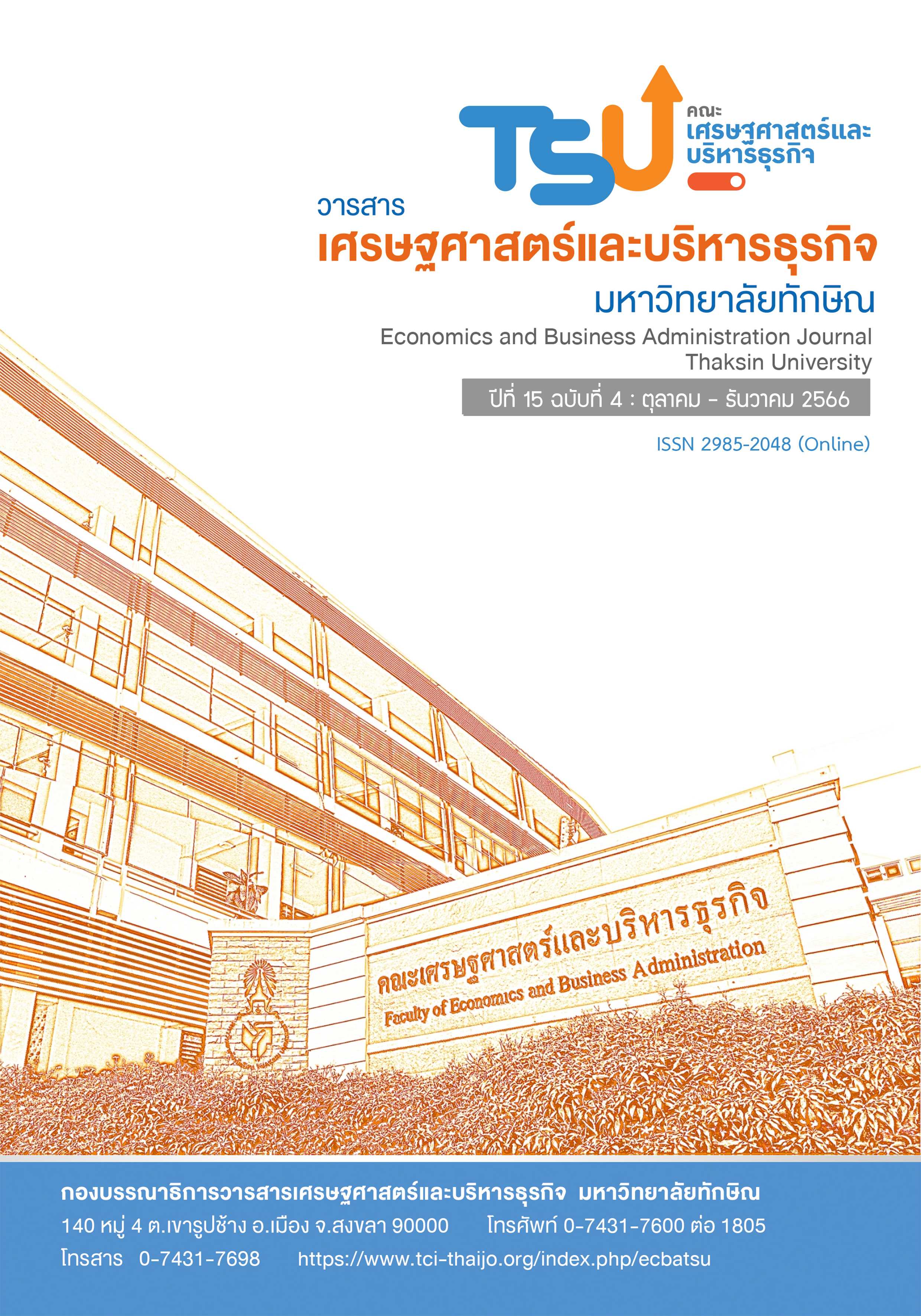Determinants of Thailand’s Domestic Systemically Important Banks’ Deposits under the Coronavirus Disease 2019 Crisis and its Response to ESG Image and Cryptocurrency Investment Trend
DOI:
https://doi.org/10.55164/ecbajournal.v15i4.263432Keywords:
Deposit, Commercial Bank, Coronavirus Disease 2019, ESG, CryptocurrencyAbstract
The purposes of this study were to identify macroeconomic factors and bank-specific factors that determined banks’ deposits, and the impacts of bank ESG images and cryptocurrency investment trend on Thailand’s domestic systemically important banks’ deposits (D-SIBs’ deposits). This research used monthly secondary panel data from 5 D-SIBs from January 2019 to June 2022. The data were analyzed by econometric methods including LLC’s panel unit root test, Kao’s panel cointegration test, panel regression analysis, and panel cointegration regression analysis using the weighted FMOLS method. The results showed that in the short run, changes in government bond yield, changes in SET index, changes in consumer price index, S&P global ESG scores, and changes in number of cryptocurrency accounts had significantly positive relationships with D-SIBs’ deposits. However, consumer confidence index and deposit protection limit had significantly negative relationships with D-SIBs’ deposits. In the long run, real gross domestic product per capita, government bond yield, the number of unemployed under SSO, deposit interest rate, S&P global ESG scores, and number of cryptocurrency accounts had significantly positive relationships with D-SIBs’ deposits, whereas SET index, consumer price index, consumer confidence index, deposit protection limit, number of system failures, and liquidity coverage ratio had significantly negative relationships with D-SIBs’ deposits. Therefore, if the government or Bank of Thailand would like people to reduce their deposits and spend for economic stimulus purpose, they should increase consumer confidence. For D-SIBs, the good ESG images can help to increase their deposits both in the short and long term.
References
Asayesh, H., Mohammadi, M., Zahed, M., & Abolhasani, A. (2017). Factors Affecting the Banking System's Deposits. Best Journal, 5(6), 23–28. Retrieved from https://www.journals.indexcopernicus.com/api/file/viewByFileId/154017.pdf
Bank of Thailand. (2022). Statistics of Financial Institutions. Retrieved from https://www.bot.or.th/English/Statistics/FinancialInstitutions/Pages/default.aspx
Chockpisansin, K. (2020). Analysis of Financial Markets and Financial Institutions. Retrieved from https:// www.kasikornresearch.com
Demirgüç-Kunt, A., & Kane, E. (2002). Deposit Insurance Around the Globe: Where does It Work?. Journal of Economic Perspectives, 16(2), 175–195. Retrieved from https://www.pubs.aeaweb.org/doi/pdfplus/10.1257/0895330027319.
Gwartney, J, Stroup, R., Sobel, R., & Macpherson, D. (2020). Economics (16th ed.), South-Western Cengage Learning.
Hausman, J.A. (1978). Specification Test in Econometrics. Econometrica, 46(6), 1251-1271.
Kao, C. (1999). Spurious Regression and Residual-based Tests for Cointegration in Panel Data. Journal of Econometrics, 90(1), 1-44.
Levin, A., Lin, C.F., & Chu, C. (2002). Unit Root Tests in Panel Data: Asymptotic and Finite-sample Properties. Journal of Econometrics, 108(1), 1-24.
Mahapornprajak, T. (2021). Get to Know ESG, A Sustainable Business Trend. Retrieved from https://www.bot.or.th/Thai/ResearchAndPublications/articles /Pages/Article_22May2021.aspx
McKinnon, RL. (1973). Money and Capital in Economic Development. Washington, D.C.: The Brookings Institution.
Morina, F., & Osmani, R. (2019). The Impact of Macroeconomic Factors on the Level of Deposits in the Banking Sector, an Empirical Analysis in the Western Balkan Countries. Journal of Accounting Finance and Auditing Studies (JAFAS), 5(3), 16–19. Retrieved from https://www.researchgate.net/publication/334594841_ The_impact_of_macroeconomic
Office of the National Economic and Social Development. (2021). Thai Economy in the Fourth Quarter, and Full Year 2020 and Trend in Year 2021. Retrieved from https://www.nesdc.go.th/ewt_ dl_link.php?nid=11268&filename=index&fbclid= IwAR23q2PVCJR1z0egpRVwzu6jlaAkdK3Cf-gh4U1n3bnPWrG9UmFG0CSwQEM.
Parinyavuttichai, P. (2022). Revealing the Results of A Survey of Thai People's Interest in Digital Assets, Found 46% of Them Aiming for Speculation. Retrieved from https://www.sec.or.th/TH/Template3/Articles/2565/170565.pdf
Pedroni, P. (2000). Fully Modified OLS for Heterogeneous Cointegrated Panels. Nonstationary Panels, Panel Cointegration, and Dynamic Panels, 93-130.
Pinto, S., & Premsin, J. (2012). Economics (1st ed.). Bangkok: Bank of Thailand
Promlao, K. (2021). What Is the ESG Concept? Why Are Investors Interested In It? Retrieved from https://www.tris.co.th/wp-content/uploads/2021/05/2564_ Article_250564.pdf
Saikanit, R. (2013). Principle of Economics II: Macroeconomics (5th ed.). Bangkok: Chulalongkorn University Press.
Shaw, E. (1973). Financial Deepening in Economic Development. New York: Oxford University Press.
Teswanitch, J. (2002). Finance and Banking (4th ed.). Bangkok: Odeonstore.
Thummasaroch, J. (2014). Business Strategies for a Competitive Advantage of Music School in Chaiyaphum Province. Unpublished Master Thesis. Bangkok: Silpakorn University.
Vorapongsathon, T. (1989). Considerations in Using Multiple Regression for Research. Thai Journal of Health Research, 3(1), 55-62.
Wongsawas, S. (2018). Factors Affecting the Deposit Volumes in the Commercial Banking System in Thailand. Journal of Thonburi University, 12(27), 122-134. Retrieved from https://www.thonburi-u.ac.th/journal/Document/12-27/Journal12_27_11.pdf
Downloads
Published
How to Cite
Issue
Section
License
Copyright (c) 2023 Faculty of Economics and Business Administration, Thaksin University

This work is licensed under a Creative Commons Attribution-NonCommercial-NoDerivatives 4.0 International License.




